Or – “What All The Hubbub Has Been About…”
Back in 1971, Gary Friedrich was one of Marvel’s celebrated Bullpen, working on such comic-book stalwarts as The Incredible Hulk, Captain America and a the pre-Wolverine (and just barely pre-cancellation) Uncanny X-Men. His co-creation of Ghost Rider in Marvel Spotlight #5 was one of the bellwethers of a phenomenon of monster anti-heroes in comics, and cemented the flaming-skulled cyclist as one of Marvel’s most recognizable second-tier heroes. (As an aside, he created an earlier hero with a similar gimmick, the short-lived Hell-Rider.)
With the recent ruling in Gary’s lawsuit against Marvel, I thought it might be a good time to take a look in the Longbox Of Doom at the stories over which this legal battle has been waged…
 GHOST RIDER #1
GHOST RIDER #1
Scripter: Gary Friedrich
Penciler: Tom Sutton
Inker: Syd Shores
Cover Artist: Gil Kane
Colorist: George Roussos
Letterer: John Costanza
Editor: Roy Thomas
Publisher: Marvel Comics
Cover Price: 20 Cents
Current Near-Mint Pricing: $120
Previously, in Ghost Rider: A child of tragedy, Johnny Blaze had already lost his mother and father when he became a stunt rider in Crash Simpson’s traveling show, and it was certainly this sense of loss that led to his inexplicable later actions. When confronted with the reality that his adoptive father was dying of cancer, Johnny Blaze called up De Debbil himself and offered his soul in return for a remission of Crash’s cancer. The infernal pact was settled, only for Crash to die in a flaming wreck during one of his own stunts, an accident strongly implied to have been CAUSED by the deal Johnny made to save Crash’s life. When Satan returned for his soul, Johnny’s lady-love Roxanne managed to fend off the evil one with her purity of soul, but not before the Lord Host of the Hoary Netherworld got in a cheap shot at ‘the one that got away.’ Now, when night falls, Johnny Blaze’s flesh burns away, and he is forced to walk the night as a monstrous presence known only as… The Ghost Rider!
By all accounts, Ghost Rider’s early issues sold like the proverbial hotcakes, and less than six issues after his debut, Johnny’s alter-ego was given his own magazine. This issue begins in split screen, as an unseen person leaves an offering on a grave in New England, while Johnny Blaze roars across the Arizona desert…

First and foremost, it’s really impressive to see how they weave the information you need to know into the story. Marvel has been good these days about using the title page to give readers an overview, but I find it much more satisfying to see the expositionary dump done in this style. Johnny crashes through the police barricade successfully (a minor miracle in itself) but takes a police bullet in the shoulder, causing his bike to veer out of control into the desert…

I honestly don’t remember why Johnny is wanted by the police at this point in time (although it might have something to do with his early stories suffering from a pretty vicious case of ‘Bruce Banner syndrome,’ wherein everyone he meets is either a sociopath or a sadist) but he is quickly taken into custody and evacuated to the nearest hospital. Things aren’t any brighter back on the Indian Reservation, where Ghost Rider’s last opponent, Witch Woman, is paralyzed, seemingly possessed by some sort of unearthly presence. Her brother makes a desperate call for help, which leads us to…
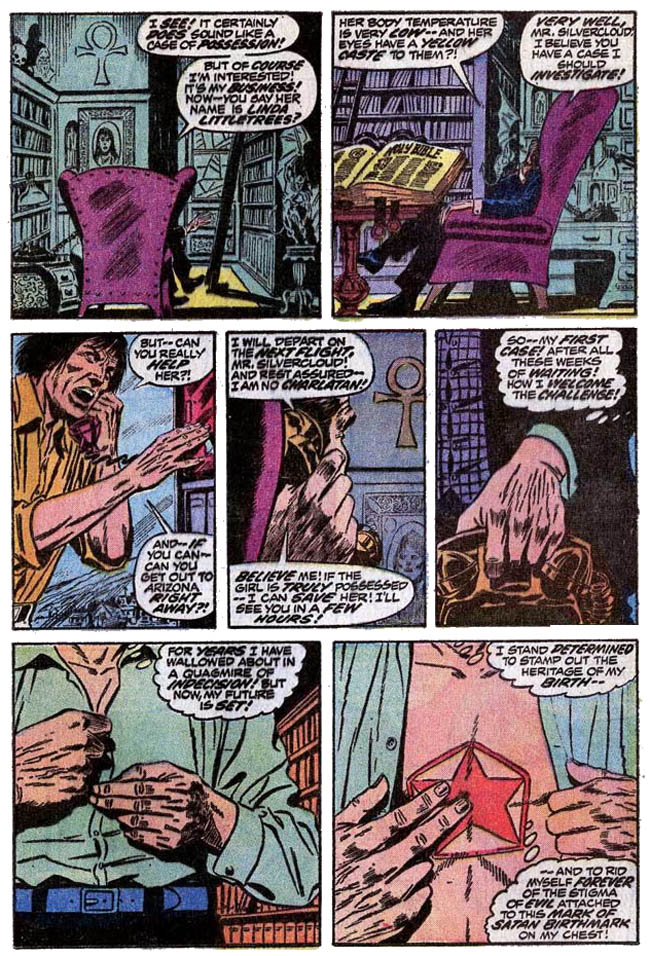
Remember the mysterious figure on page one? Though his face is still obscured, there’s no mistaking that chest symbol, and the wise Marvel fans amongst us have already figured out: Ghost Rider #1 is also the first appearance of Daimon Hellstrom, the erstwhile Son of Satan! First appearances were a different beast back in the day, and rather than get straight to a big splash page of Daimon in full raiment, Friedrich chooses to build suspense about the true nature of the (son of) the beast. It’s a choice that I wholeheartedly agree with, especially when we find that Witch Woman’s possessor is none other than the Hellstrom pater familias. Could it be…
SATAN???
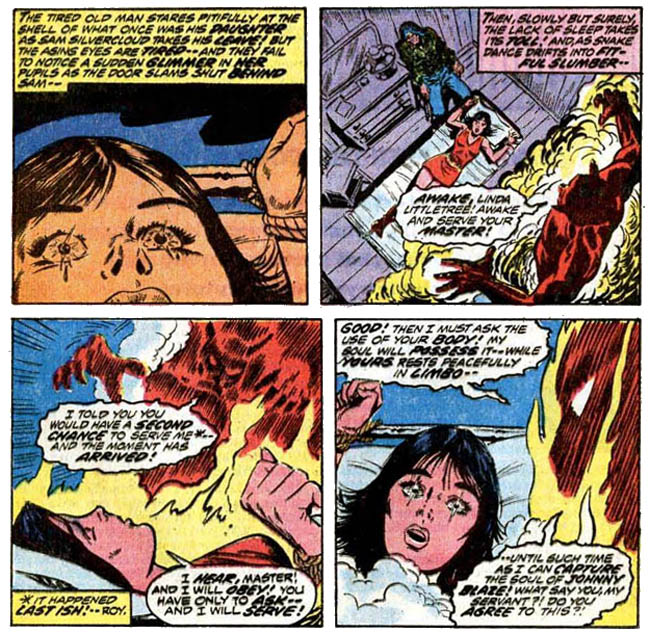
The use of the literal embodiment of Satan has always been a fascinating choice to me, especially given that one of Marvel’s biggest guns is Thor of the Norse gods. In a very real way, the extension of the Christian symbology that we see in the stories of Ghost Rider and Son of Satan makes a certain kind of sense (even as it lacks the typical 21st Century PC restraint.) Johnny’s first twenty or so appearances are actually a battle against the literal devil, identified and named as such (even if later tales retcon in Mephisto as the one who made the pact with Johnny and rename Daimon’s father as Marduk.) Linda Littletree accepts the bargain of Satan and races out into the evening as a pawn of Satan, while Johnny Blaze comes to his senses.
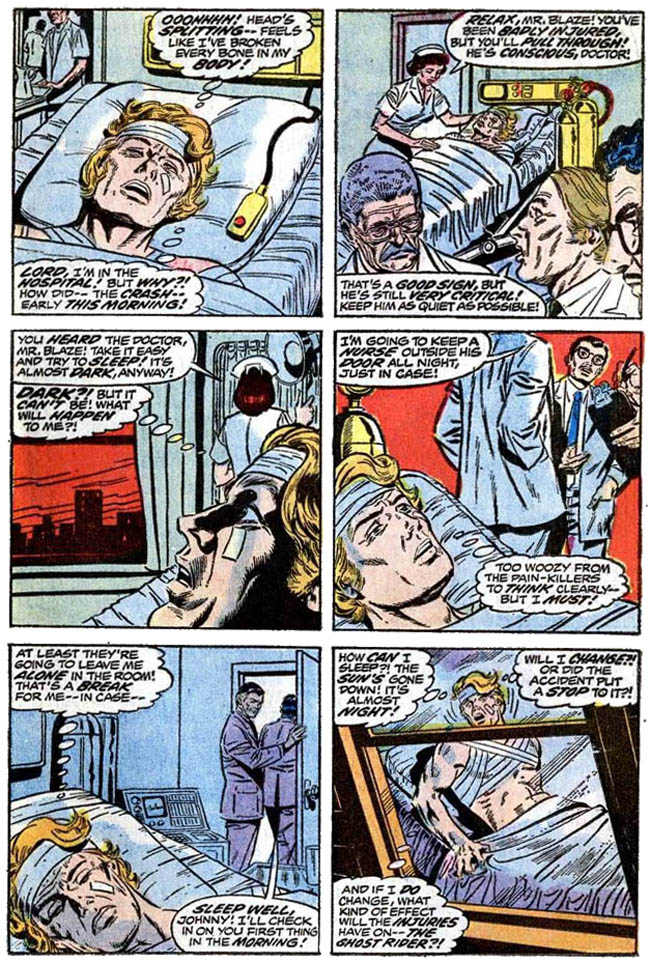
Wow, John. That’s a lot of questions all at once, isn’t it? The answers, in order: Ya can’t. Yes. No. Not really any, as far as we can tell. Not only does nightfall bring out the Ghost Rider, but it mystically puts him back in his black and blue leathers as well. Hilariously, Johnny jumps in a cab and orders the driver to rush him to Copperhead Canyon, the site of his next big stunt jump. Apparently, Johnny’s identity is known to the world, but most of the general public thinks that his skull-headed guise is nothing more than a gimmick. ‘Course, Johnny doesn’t realize that his manager, Bart, has chosen to do the stunt in John’s seeming absence…
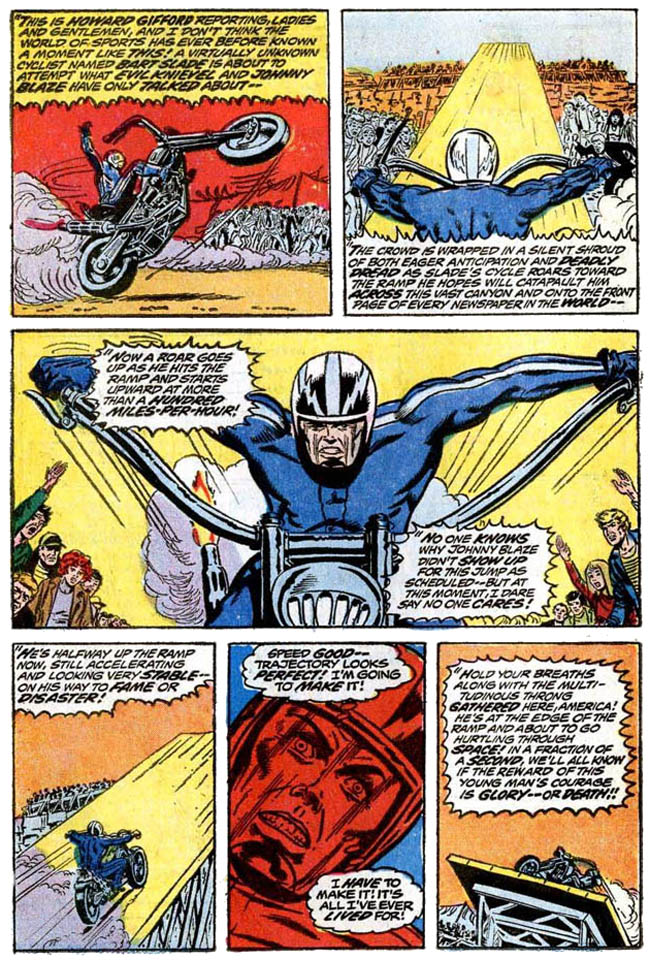
Herb Trimpe is a wonderful artist, and his Hulk stories are some of my favorite Marvel moments ever. Even on early issues of G.I. Joe, Herb rocked the pencils and brought to life some of the most awesome characters of my childhood. That said, the motorcycle in panel three is simply ridiculous. I’m sorry, Mr. Trimpe, wherever you are. Please forgive me. Aaaaaanyway, Bart’s stunt (which is to say, Johnny’s stunt) is clearly modeled after Evel Knievel’s attempt to jump across the Snake River back in the day. In both cases, though, the stunt ends… poorly.

So, to recap: Your best friend has just exploded. Your critically injured girlfriend is unconscious from the shock of seeing you. The cops are ready to haul you in. How do you respond? Steal a truck and go all ‘Beau and Cledus’ on ’em! Before anyone can ask what just happened (or why the stunt was scheduled at night, even though the art doesn’t seem very night-like), Johnny is once again on the run from Roscoe and Enos, racing against the clock to… do… something. I’m not entirely sure what he has to gain by fleeing, honestly, and Johnny himself seems to realize the same as the issue ends…

Interestingly, though Ghost Rider had graduated to his own title, his appearances in Marvel Spotlight continued for another issue or two, and the transition to it’s new star (none other than Daimon Hellstrom himself) is one of the best-executed “backdoor pilot” attempts in Marvel’s history. The early stories paint Johnny Blaze as a not-too-bright and not particularly noble character, and his adventures as The Ghost Rider are often driven by his tendency to run away from his problems at high speed rather than deal with the consequences of his bad decisions. And, completely apropos of nothing other than the fact that I’m fascinated by it, the issue also features this ad:
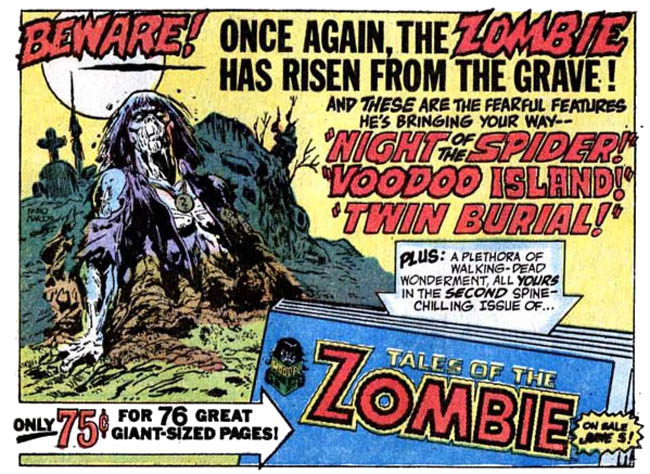
Having recently reread the Essential Tales Of The Zombie, I have to say that I hope that kids of the era didn’t pick the thing up and start reading thinking it was going to be like the semi-superhero antics of Ghost Rider, Satan or no Satan. (Now that I mention it, Simon Garth, the Zombie, might make for an entertaining Hero History… Who’s up for that one?) In any case, it’s easy to see why Ghost Rider grabbed the attention of the reading public, as this whole issue is a frenetic thrill ride, leaping from plot point to plot point with the joyful air of “Hey, look at this cool thing!” without ever losing the underlying tone that this is all pretty gruesome stuff. Our hero sold his soul, after all, and the melodrama inherent in that is too good to ignore. Aside from the occasional not-so-realistic motorcycle (and, honestly, in the 10 years of Ghost Rider stories, there were few who actually drew a realistic motorcycle), the art is Bronze Age cool, and Friedrich delivers a complex story that builds on what has come before, making even the villains sympathetic and believable. Whatever you may think about the suits and countersuits, Ghost Rider #1 is a fine book, well worth the three-digit price point you’ll encounter for a nice, clean copy, earning 4 out of 5 stars overall.



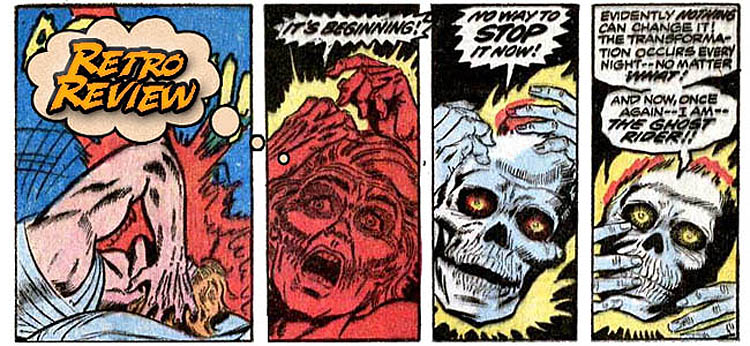
2 Comments
Ghost Rider, although judged as a B character, is one of my favorite Marvel characters. It is a shame that the movies don’t do the property justice. I grew up on the Danny Ketch version, and read up on the Blaze version later. I would love to see your opinion of the 90’s reiteration of the Ghost Rider #1(seeing as we are on topic with the lawsuit). Make Mine majorspoilers!!!!!
If you’re a fan of Danny Ketch, you may not want my feedback on his earliest stories. :) I read his Ghost Rider for roughly the first 20 issues or so in the 90’s…
But, now that you mention it, I’ll chuck him on my Retro Review pile. :D